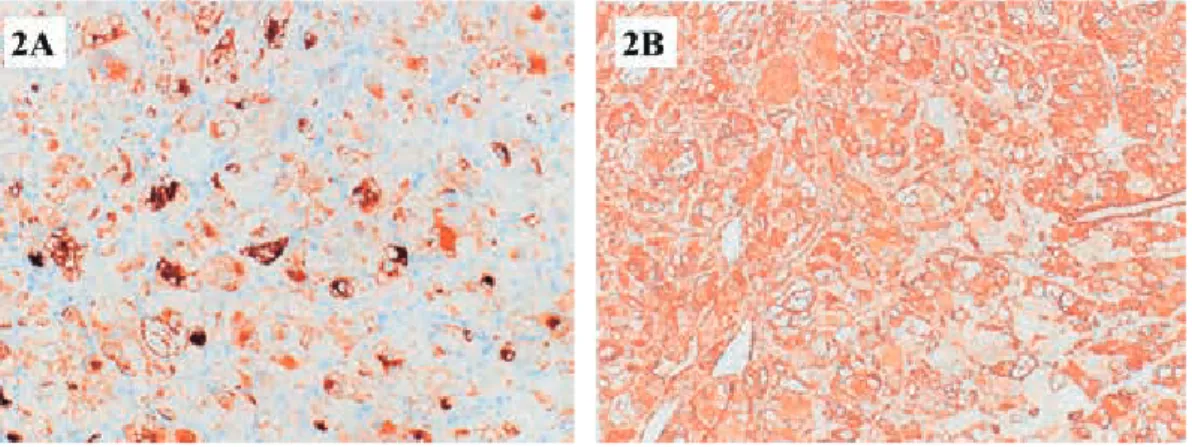︿ Review ﹀
Review of renal epithelioid angiomyolipoma with focus on clinical and pathobiological aspects
Naoto Kuroda,
1Kenji Yorita,
1Chisato Ohe,
2Fumiyoshi Kojima,
3Ikuma Kato,
4Shuji Mikami,
5Motsuko Furuya,
4Yoji Nagashima,
6Chin-Chen Pan,
7Jose Ignacio Lopez,
8Ondrej Hes,
9Michal Michal
9and Mahul B. Amin
10Abstract :
Epithelioid angiomyolipoma (eAML) is a rare renal neoplasm, in which the proportion of epithelioid cells in eAML accounts for more than 80% of the entire lesion. eAML often occurs with tuberous sclerosis complex as well as a sporadic manner. Histologically, the tumor predominantly consists of epithelioid cells with eosinophilic to clear cytoplasm, frequently showing pleomorphic ganglion-like or multinucleated giant cells. Spindle cells or adipose tissue also proliferate. Perivascular hyalinization and entrapped tubules are frequently identified. Immunohistochemically, neoplastic cells usually show the positivity for melanoma- related antigen (HMB45, HMB50, CD63, and Melan A), and alpha-smooth muscle actin. Ultrastructurally, epithelioid cells contain striated, rhomboid, spherical or elliptical granules which may mimic melanosome, renin granules or rarely form typical premelanosomes. Approximately 40 % of cases with eAML behaves aggressively. As the investigation on indicators of clinical behavior is not enough to date, the accumulation and further examination of cases with eAML is required in the near future.
Keywords : epithelioid angiomyolipoma, kidney, pathology
1
Department of Diagnostic Pathology, Kochi Red Cross Hospital, Kochi, Japan,
2Department of Diagnostic Pathology, Kansai Medical University, Osaka, Japan,
3Department of Diagnostic Pathology, Wakayama Medical University, Wakayama, Japan,
4
Department of Molecular Pathology, Yokohama City University Graduate School of Medicine, Yokohama, Japan
5
Division of Diagnostic Pathology, Keio University School of Medicine, Tokyo, Japan,
6Department of Surgical Pathology, Tokyo Women’s Medical University, Tokyo, Japan,
7Department of Pathology and Laboratory Medicine, Taipei Veterans General Hospital and National Yang-Ming University, Taipei, Taiwan,
8Department of Pathology, Cruces University Hospital, Biocruces Research Institute, University of the Basque Country (UPV/EHU), 48903, Barakaldo, Spain,
9Department of Pathology, Charles University in Prague, Faculty of Medicine in Plzen, Plzen, Czech Republic, and
10Department of Pathology and Laboratory Medicine, University of Tennessee Health Sciences Center, Memphis, USA
Correspondence: Naoto Kuroda, MD, Department of Diagnostic Pathology, Kochi Red Cross Hospital, Shin-honmachi 2-13-51, Kochi City,
Kochi 780-8562, Japan. Email: kurochankcohi@yahoo.co.jp
INTRODUCTION
Renal angiomyolipoma (AML) is composed of various proportions of thick-walled blood vessels, smooth muscle and adipose tissue.
1-4This lesion has been for a long time considered to be a hamartoma, but is now regarded as a tumor.
5,6Eble et al. has propose the entity of renal epithelioid AML (eAML) which predominantly consists of epithelioid smooth muscle cells.
7However, the ratio of epithelioid cells
in eAML varies from 10% to 100%, depending on the definition of reported papers.
7-15The biological behavior of eAML is also quite variable.
7-15In this article, we review eAML with focus on clinical and pathological aspects.
DEFINITION
According to the recent World Health Organization
Classification, eAML is a rare variant of AML and
the ratio of epithelioid cells in eAML is defined as more than 80% of total neoplasm.
16EPIDEMIOLOGY
eAML is often associated with tuberous sclerosis complex, but may occur also in sporadic fashion.
4,7,8eAML accounts for 4.6% of all AMLs.
12CLINICAL SYMPTOMS
Patients generally present with pain, hematuria, mass and fever. Some tumors are incidentally found.1 In cases of association with tuberous sclerosis complex (TSC), symptoms are caused by involvements of organs other than the kidney (seizure due to cortical tuber, dyspnea due to pulmonary lymphangiomyomatosis, facial angiofibroma and mental retardation).
IMAGING FINDINGS
The contrast computed tomography (CT) scan examination of eAML generally reveals a solid hypervascular tumor with homogenous or heterogenous enhancement.
17The predominant enhancing pattern is rapid wash-in to slow wash- out.
17PATHOLOGICAL FINDINGS MACROSCOPIC FINDINGS
The tumor shows well-demarcated and solid mass. The cut surface of the tumor shows tan, grey or pink color with occasional hemorrhage or necrosis.
7, 18MICROSCOPIC FINDINGS
The tumor predominantly consists of epithelioid cells (Fig.1a). Pleomorphic ganglion-like or multinucleated giant cells are frequently observed (Fig. 1b).
4,12In some cases, spindle cells or adipose tissue proliferate.
10,12Perivascular hyalinization is often noted (Fig.1c).
12Entrapped tubules are
frequently identified.
4,9Mitotic activity is variable.
4,9
